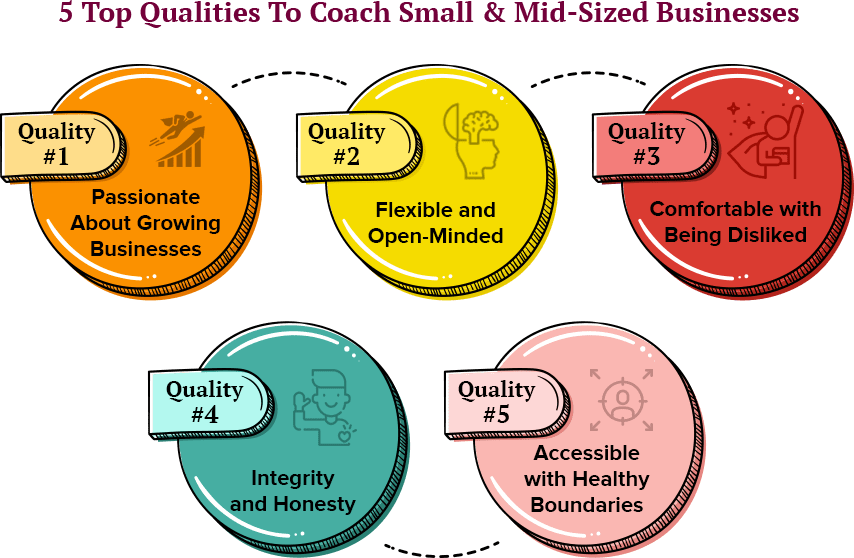CHAPTER 2
5 Damaging Myths Around Small & Mid-Sized Business Coaching
There are a ton of myths around what it takes to be a business coach and some of these myths have been floating around the coaching industry for years.
Unfortunately, these false ideas and beliefs have been holding back countless gifted, talented coaches from fulfilling their potential and living their dream of becoming an extraordinary business coach…
Luckily, you’re not going to be one of them!

Let’s take a look at some of the most damaging and deeply misguided myths around small and mid-sized business coaching.
Myth #1:
You Need To Coach Around The Clock
A lot of coaches believe that you need to coach pretty much day and night to generate revenue in your coaching business and they also believe that small and mid-sized companies can’t pay well.
This is 100% false.
One survey on Protoly reveals that the median hourly rate for coaches is just over $400 and lots of companies are willing to pay that.
This is why many business coaches are generating massive income every year!
So forget about this myth and understand that when you have great coaching skills and you know how to connect with the right clients, you’ll quickly grow your coaching business to 6 or even 7-figures.
Myth #2:
You Need To Be More Successful Than Your Clients
This is a huge myth and it’s the reason behind many non-starters in the coaching business industry.
The truth is you don’t need to make more money, have extraordinary business skills or be better than your client in all areas, because a coach’s role is to help clients identify their problems and then guide them towards finding a solution that works.
So you don’t need to be the best at everything…
You just need to be the best coach you can be.
Myth #3:
You Only Need To Coach When There’s Trouble
Just about every business needs a great coach and this is the case whether the company is in “trouble” or not.
Coaching isn’t just about helping Founders and business owners get out of a problem or overcome failure. It’s also about creating powerful visions and goals, reaching potential, managing and scaling the business and so much more.
The idea that you need to focus on companies that are having issues is just not true.
The best coaching results often happen when you’re working with a company to help them avoid major pitfalls and challenges in the first place and not just working to apply a “band aid” solution when things have already fallen apart.
Myth #4:
You’ll Have To Coach Unsuccessful Companies
This is an unfortunate myth or belief that comes from the idea that high performers and successful businesses don’t need a coach.
The opposite is true.
People and companies who stubbornly hold onto methods that don’t work rarely reach out to get help from a coach who can get them back on track.
High performers, on the other hand, are more than happy to ask for help from skilled experts.
Business coaches often end up coaching winners who have a burning desire to reach for bigger, better goals.
Myth #5:
You Need To Coach Anyone Who Asks for Help
If you’re a coach or thinking about becoming one, here are 2 things that are true about you:
1. You’re generous and giving
2. You want to help as many people as possibleThese are wonderful traits and they’re important in your work as a business coach but they can also be your worst failings.
There’s a cold, hard truth you need to know and it’s this…
You can’t be everything to everyone so don’t even try!Your best work as a coach will come through when you’re able to set boundaries with clients and when you work with people and companies that are aligned with your values.
So don’t make the mistake a lot of new – and even experienced – coaches make. Don’t feel like you must coach anyone and everyone who hires you.
This is a big mistake and you’re guaranteed to regret it sooner rather than later.

Now that you’re familiar with the top 5 myths around coaching companies, it’s time to look at installing positive beliefs that support you in your journey to becoming a successful small and mid-sized business coach.
Part 1 :
First thing to do is to “catch” your current negative or limiting thoughts and beliefs around coaching.
A simple way to do that is to look out for the following words in your mind and in your speech:

Take some time – maybe a few days and up to a week – to note down your negative thoughts and beliefs about becoming a business coach.
Part 2 :
Then, choose one negative belief at a time and write about a time in your life when that belief was not true.
For instance, if your negative belief is, “I’m worried I’m not confident enough to coach companies as clients.”
Now write about the times you succeeded at something even when you didn’t feel confident, when you were nervous or uncertain. This could be the time you did well in a school exam even though you had butterflies in your stomach, or the time you crushed a public speaking gig even though you were afraid to get on stage.
Remember: no win is too small.
Write down every single time you did something that countered each negative belief and you’ll soon find that it starts to lose its grip on you and that it eventually disappears.
CHAPTER 3
5 Top Qualities To Powerfully Coach Small & Mid-Sized Companies
Lots of coaches take their best shot at working with small and mid-sized companies but most of them never get to the level of success they’re shooting for.
This usually happens because they think powerful, game-changing coaching comes from having the “right certification” or the “right qualification.”

The truth is no amount of formal training can take the place of “make-or-break” traits that help you work with companies on a deep, transformational level.
Unfortunately, most coaches end up investing a ton of time, money and energy on fine-tuning their coaching skills and not enough time developing the qualities that make the difference between being a great business coach.
Here are the qualities you need to become a masterful business coach for small and mid-sized companies:


Quality #1:
Passionate About Growing Businesses
If you’re not passionate about all things related to starting, growing and scaling a company, and if you’re not excited about helping clients uplevel their business and entrepreneurial skills, it’s time to reconsider coaching small and mid-sized businesses.
These companies often experience lots of “growing pains”, challenges and obstacles.
One of your key roles is to hold a positive, supportive space so you can guide your clients, no matter how hard things get.
You won’t be able to do that effectively if you don’t have true passion for your work.

Quality #2:
Flexible And Open-Minded

This is especially true for small and mid-sized companies that often need their coach to also be a mentor, a trainer, a facilitator, a consultant, and sometimes even a life coach.
A truly great business coach needs to be flexible, open-minded, ready and willing to step into these various roles when the need arises.

Quality #3:
Comfortable with Being Disliked
This is a tough one for a lot of kind-hearted coaches who don’t want to “upset” their clients with hard truths.
The danger with this is that a lot of good coaches end up “sugar-coating” the truth with their clients and this could lead to confusion and ultimately, less than favorable results.
A coach who’s willing to be disliked is a coach who is willing to tell the client what they need to hear and not necessarily what they want to hear.
Real growth and improvement can happen only when a coach says what needs to be said for the greater good of the company, the team and the Founders, and not just the things that gets the coach praise, approval or admiration.

Quality #4:
Integrity And Honesty
This is related to “comfortable with being disliked” where you’re committed to being honest no matter what and it’s also about being in full integrity in your work as a coach.
Never make promises you can’t keep and make sure you’re ALL in when it comes to helping your clients achieve their goals and their ultimate vision.
One great way to stay on the path of integrity is to make sure that you set expectations from the start. This helps to clear confusion and doubt and it also means both you and client are clear on what to expect, moving forward.

Quality #5:
Accessible With Healthy Boundaries
The best coaches in the world want the best for their clients and a big part of this is to make yourself easily accessible so they can connect with you and check-in with you when they need you.
Often this means giving them opportunities to reach you outside “official” coaching sessions and customizing packages or contracts so clients feel fully supported.
Just to be clear, this isn’t about letting people reach you or talk to you day and night and on holidays and weekends. Make sure you have healthy boundaries in place so your clients understand what’s acceptable and what’s not.
Healthy boundaries allow you to show up at the highest level as a coach and it creates a framework where you get to nurture a powerful, respectful and truly transformational relationship with the companies you work with.

You just learned about the 5 “make-or-break” traits you need to successfully coach small and mid-sized companies. Let’s expand on this list and add more rockstar qualities so you’ll have a deeper understanding on what it takes to become a powerful coach.
Step 1 :
Do some research over the next few days and identify 1 to 3 business coaches that you feel are great at what they do.
Step 2 :
Take some time to watch their videos on YouTube, check out some of their books or read their blog posts. Your goal is to pinpoint some of the standout qualities and traits that you can observe so you can add to the list in this chapter.
Here are some of our suggested videos to get started:
